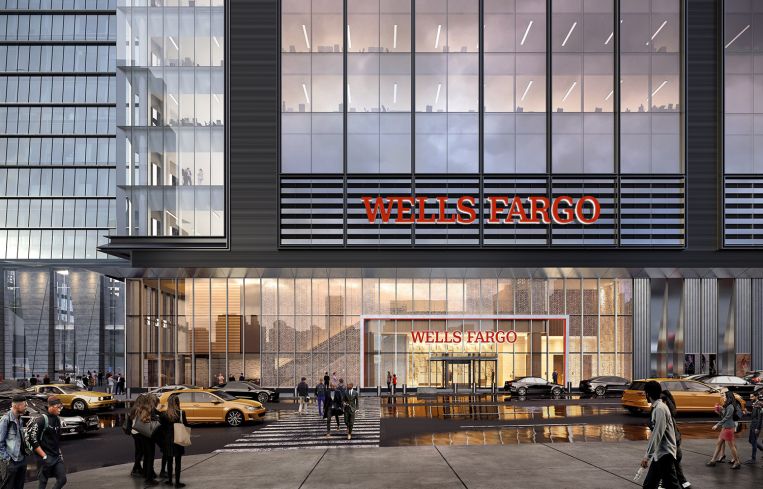Wells Fargo Real Estate Head Richard Henderson On the Hudson Yards Move
He also talks further office moves, bank branch decisions and remote work
By David M. Levitt December 12, 2023 11:00 am
reprints
Neiman Marcus’ loss turned out to be Wells Fargo (WFC)’s gain.
The Dallas-based luxury goods retailer, which emerged from Chapter 11 bankruptcy in 2021, had shuttered its first Manhattan store the year before after just one year, leaving a 188,000 square-foot hole at the center of Hudson Yards, the city’s most promising new commercial development.
But, by 2026, some 2,300 new people from the San Francisco-based bank will be working there in some 445,000 square feet overall that Wells Fargo will own rather than lease. The bank cut the deal for the space in September.
It’s going to take about three years to convert the site into the kind of modern, state-of-the-art offices Wells Fargo wants it to be, according to the bank. The employees are moving from its current offices at 150 East 42d Street, joining a large contingent of Wells Fargo workers already at another Hudson Yards location.

It’s kind of a culmination for Wells Fargo, which sees Hudson Yards as part of its identity as it becomes more and more of a New York presence, one of several banks that have become national brands that want to be on both Main and Wall streets, catering to both rank-and-file customers and wealthy investors who count on it to help them steer their investments. Others include Citigroup (C), JPMorgan Chase (JPM) and Bank of America.
Wells Fargo was the fourth-largest mortgage lender in the country last year with $79 billion of product on the books, trailing only LoanDepot, United Shore Financial and No. 1 Rocket Mortgage, according to BankRate. It was the largest conventional bank on the list, leading B of A, US Bank, JPMorgan and PNC Bank.
In a climate where corporations large and small are rethinking their commitment to offices while their workers discover they can work in or near their homes just as easily as subjecting themselves to long commutes, the Wells Fargo deal was a huge get for principal Hudson Yards developer the Related Companies. It meant the project’s most conspicuous business failure would instead become a place of business.
Richard Henderson, Wells Fargo’s head of corporate real estate and facilities, took some time during the last week of November to jump on Microsoft Teams to explain the transaction and other things Wells Fargo.
This interview has been edited for length and clarity.
Commercial Observer: Start by telling me a little bit about yourself and how you rose from wherever you were to head of corporate properties for Wells?
Richard Henderson: Well, that’s a long journey. I’ve been with the company about 30 years. I’ve been in real estate for 20, and I’ve been the leader of the function now for 10 years. So that’s a long history with the bank.
Did you start at the bottom? Maybe looking at places to put branches? You tell me.
So I spent 10 years with the firm doing things other than real estate. I moved over to real estate some 20 years ago. The firm wanted someone to do office space and then various mergers, a lot of rebranding and changes and so forth, and then selected me to be the leader of the group 10 years ago. I’ve been overseeing all of our real estate activities in the U.S. since.
So do you handle everything from where your board of directors sits down to the local branch level, or is there some kind of dividing line?
I do all aspects of real estate, including office space, data centers, call centers and operations centers. My team does all of that. When you think about the real estate life cycle, you think about strategy, transactions, construction and facility management. Some organizations have this work split. At Wells Fargo, our real estate team manages all aspects of all types of real estate. We deal with architects, general contractors and other firms that help us.
Tell me about the reaction of workers to being at Hudson Yards. You’re going to double to over 4,000 in the next few years. It sounds like you guys have found a place in New York that you really like and really like being associated with. Why is that?
First of all, regarding Hudson Yards, we were searching for a place where we could do both sales and investment banking, and the options we examined led us to believe that Hudson Yards could support those activities. We will have the same headcount in Manhattan, but bringing employees together with amenities will allow them to collaborate. Our goal is to have all our people on one site. We will have a food hall and a barista and meeting and event space, and we will support them while they’re in the office.
Sounds like there’s a benefit to being concentrated rather than spread out. Please go into a little more detail about that.
Sure. Half of our employees are in Hudson Yards, and another half are in Midtown. It’s easier for people to collaborate when you are in the same location — to challenge, to innovate, whatever it might be. Regardless of where we landed, we just wanted to get all our people together in one place. It just so happened the best place to do that was to have our employees in Midtown be in Hudson Yards to be together.
My sense of it is that Wells Fargo started out as mostly a West Coast bank, and then as regulations changed and banks started consolidating, Wells Fargo found itself in the position to strap on other banks, to go national. So you went through that transition. What was it like and what were the challenges of all that?
Twenty-seven years ago, Wells Fargo went through a series of activities that over time allowed it to expand nationwide. But the work is really the same. There’s just a lot more customers. At real estate, we’re here to enable businesses and employees of the firm to be productive and successful.
Tell me a little bit about Wells Fargo’s experiences with working from home and remote work versus returning to the office. Has that been a major challenge for you these last, say, two or three years?
We moved quickly to transition many of our employees to work remote during the pandemic. Those who hadn’t worked remotely previously learned how and adapted. We had a lot to do to prepare for our people to return to the office. We now have people coming in at least three days a week. Many of our operations and branch employees came into Wells Fargo locations throughout the pandemic to support our customers.
We’ve made some public comments about needing to continue to rightsize our workspace. Our CFO has said we had too much real estate before COVID, and we’re methodically working through that portfolio. And what we’re keeping, we’re investing in and really focusing on the employee experience and the needs of our employees.
Regarding the whole New York region, is Wells Fargo expanding or reducing its footprint?
We’re being pretty consistent. We had a future expiration that we really needed to plan for, and we really wanted to bring all our employees in Manhattan together. We think they are more effective when they are working together.
Why did Wells Fargo decide to buy space rather than do what most companies do, which is lease space?
If you talk about what’s happening at other parts of Hudson Yards, it’s a matter of what was available. We looked at the option of purchasing. In this case, it was more about bringing our employees together in one place, and we were able to.
Does it give the company a greater sense of security to own the space rather than lease it? Most companies don’t do what Wells Fargo did.
In our portfolio, we have a pretty good mix of both leased spaces and owned spaces. In markets where we know we’re going to be there a long time, ownership gives us a bit more financial certainty. But we make all those decisions situationally.
Can you say what this is costing your company?
We have not shared that publicly.
I know that Wells Fargo at least at one time was in the Seagram Building, which is high-level architecture on Park Avenue, a New York City landmark. Is that part of the consolidation to the Yards?
It’s really about, as we’ve discussed, giving us the opportunity to work together. Wells Fargo previously had our sales and trading and investment banking functions in the Seagram Building. It’s a beautiful building and we really enjoyed our time there, but Hudson Yards provided a better, modern environment for trading.
What is Wells Fargo’s level of concern that Neiman Marcus was not able to make a go of it at the Yards?
I don’t really have a lot of insight into that. There’s a little bit of work to be done. But I’m very excited about what used to be a retail store and the possibility of making it into a really terrific office space with high ceilings. I’m really excited about what we’re doing in that real estate.
So there’s a story out that says that at the same time Wells Fargo is approving the deal to go into the Yards, it is also shutting down some 300 branches. Why is that? Does that mean the bank is going to be more focused on things like wealth management as opposed to Main Street retail, or would it be a mistake to read it that way?
Every year we review and adjust our branch portfolio on an ongoing basis. Perhaps we do some additions. We review our branch network to support our customers. You’re always looking at where your customers are, and where you need to change your distribution, and in some cases we consolidate locations or relocate down the street, and in some markets we are expanding. Our consumer banking business is always changing.
What is the future of Wells Fargo going forward, and how will that future be reflected in your real estate footprint?
If you’re looking at the future, we believe — and we have said publicly — that we will have less real estate, and we will continue to invest in the employee experience in the locations we retain. We will continue to bring more services and amenities and tools for our employees.
The workplace has changed significantly in my career. I did not have a laptop computer when I started. We will see what the future of work holds and adapt our workplaces accordingly.
You mentioned data centers before. It does seem that more and more banking is done over the internet.
More transactions with our customers are now online. The pandemic accelerated the transition to digital for some. Many of us never ordered groceries or food delivery before the pandemic. We meet our customers in how they want to interact with Wells Fargo. In some instances that is in branches or buildings, and in some cases that is online. So we will have to adapt to customer behavior and adjust our real estate as needed.



